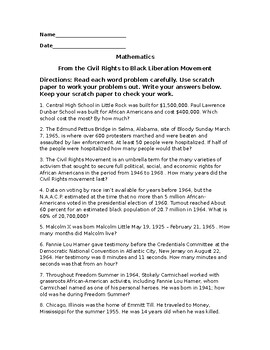Mathematics - From Civil Rights to Black Liberation Movement
- Rich Text Format
Description
This worksheet titled "Mathematics: From the Civil Rights to Black Liberation Movement" combines math problems with historical facts related to the Civil Rights Movement and the Black Liberation Movement. Here's a simple overview.
Content Overview:
- Title: Mathematics: From the Civil Rights to Black Liberation Movement
- Objective: Integrate mathematical problem-solving skills with historical knowledge to engage students in both subjects.
Worksheet Summary: This worksheet presents math problems linked to historical events and figures from the Civil Rights and Black Liberation Movements. Students are instructed to read and solve each word problem carefully using scratch paper.
Educational Value:
- It fosters a connection between mathematics and history, encouraging students to apply their math skills to real-life contexts.
- The problems incorporate historical facts, which can spark students' interest in learning about the Civil Rights and Black Liberation Movements while practicing math.
- By solving these problems, students develop critical thinking, problem-solving, and time calculation skills.
Conclusion: The worksheet effectively combines math and history, making it an engaging tool for teaching both subjects. It not only reinforces math skills but also promotes an understanding of significant historical events and figures within the context of the Civil Rights and Black Liberation Movements.



